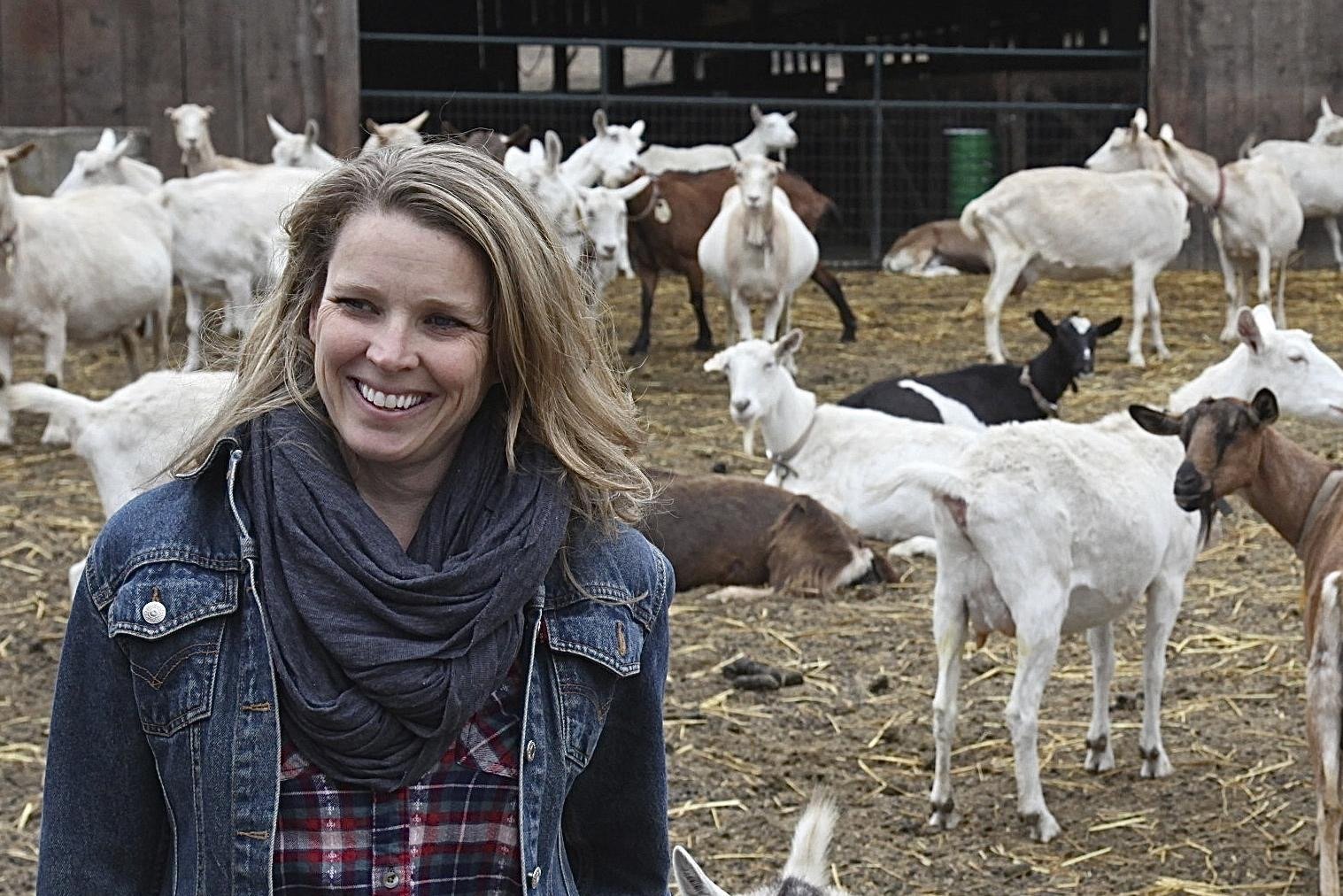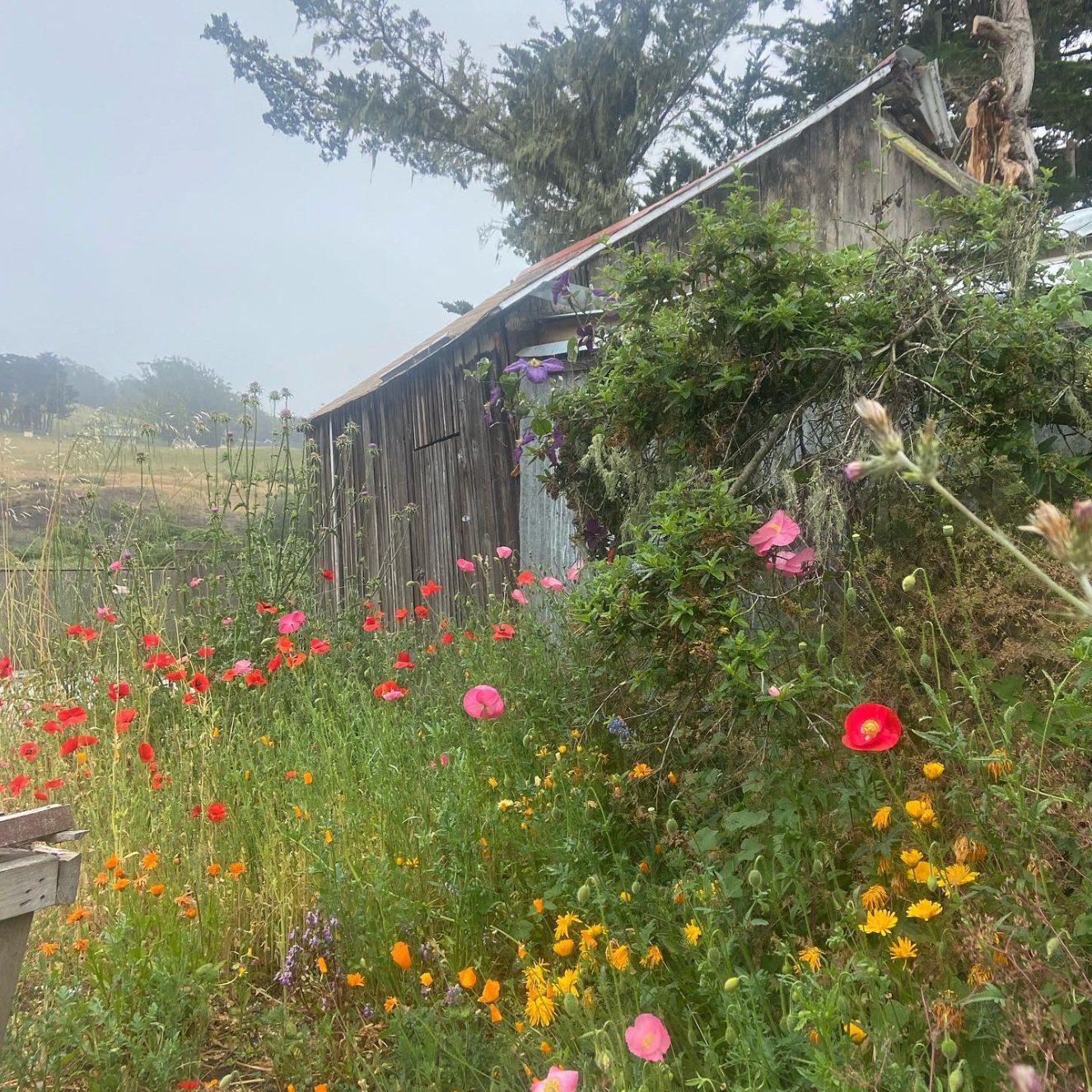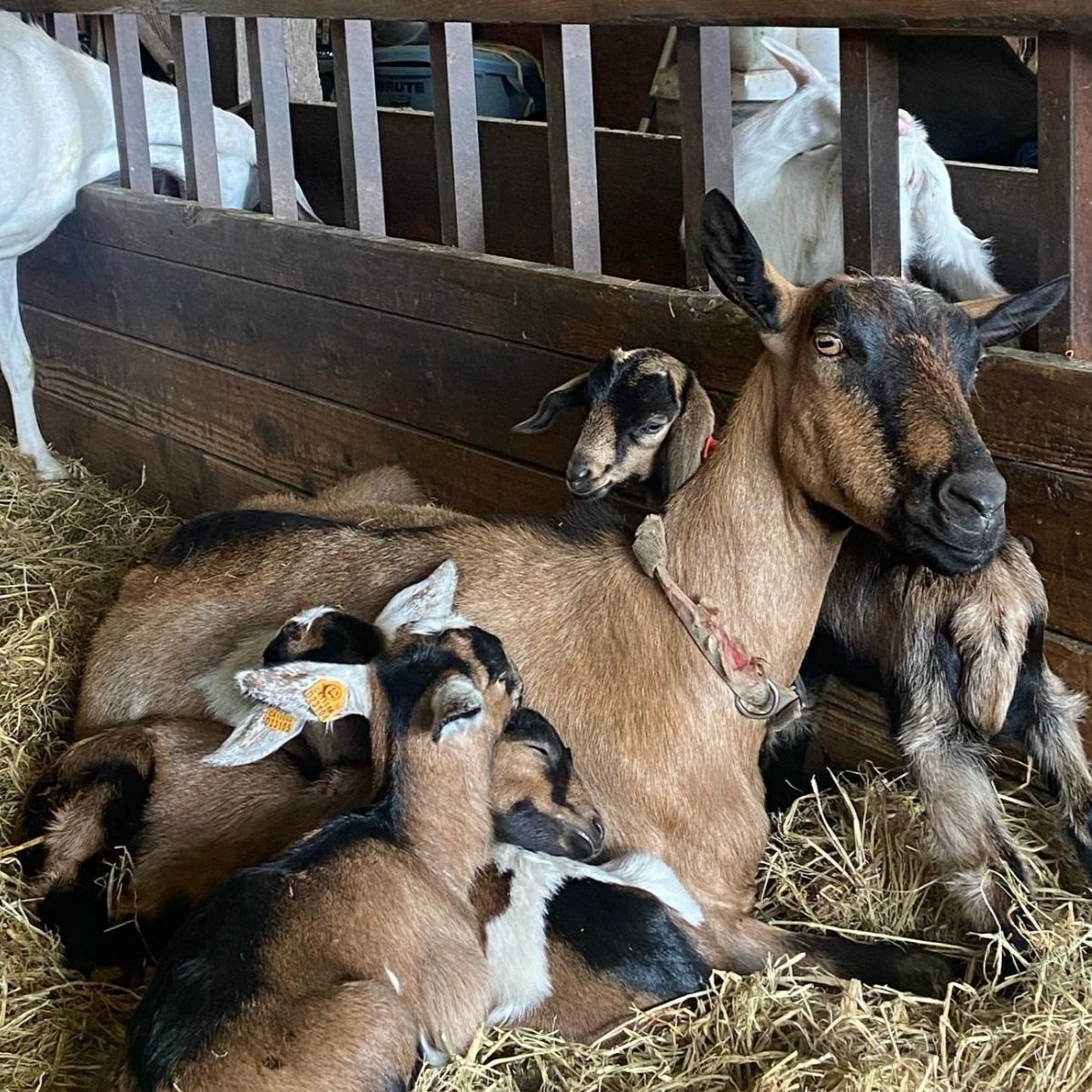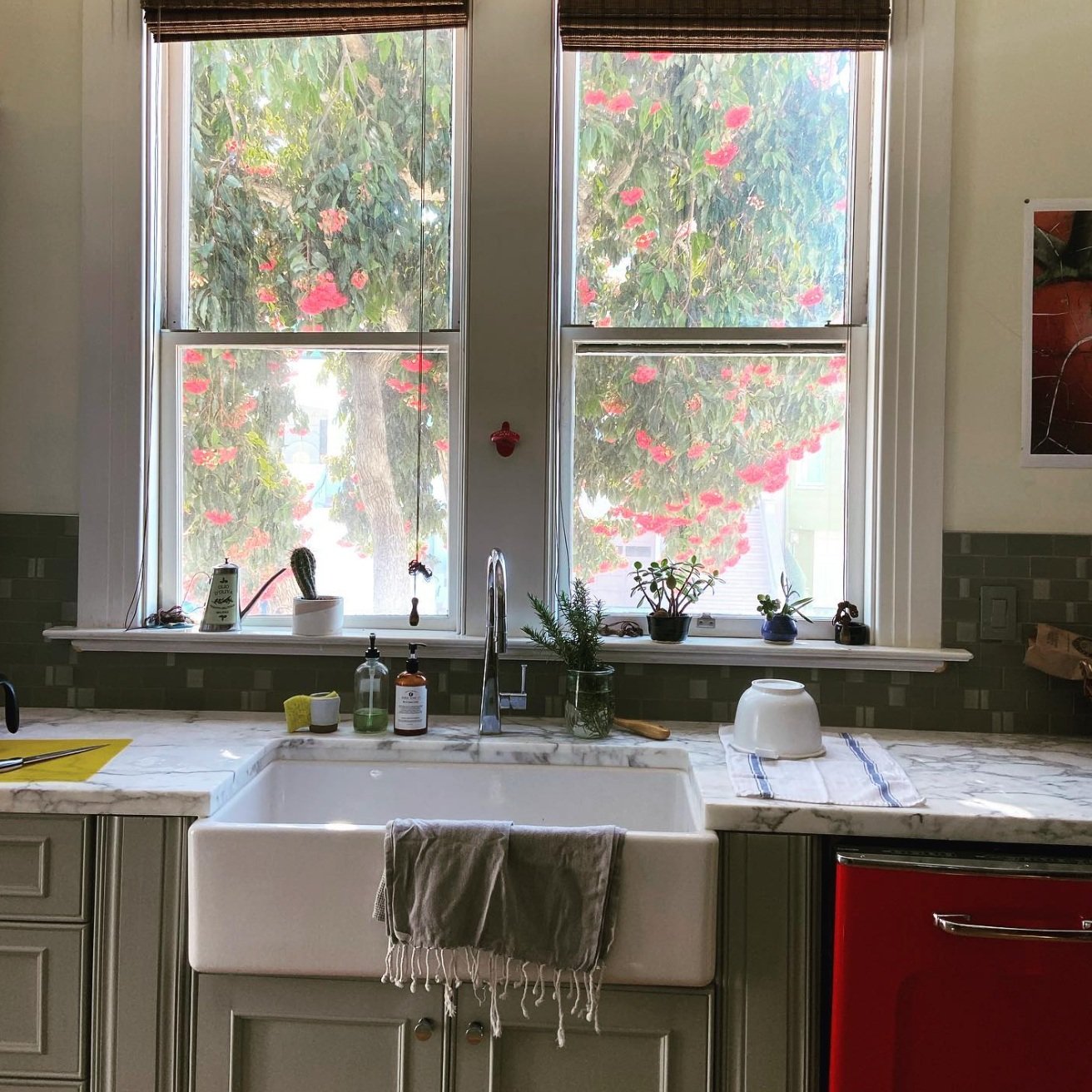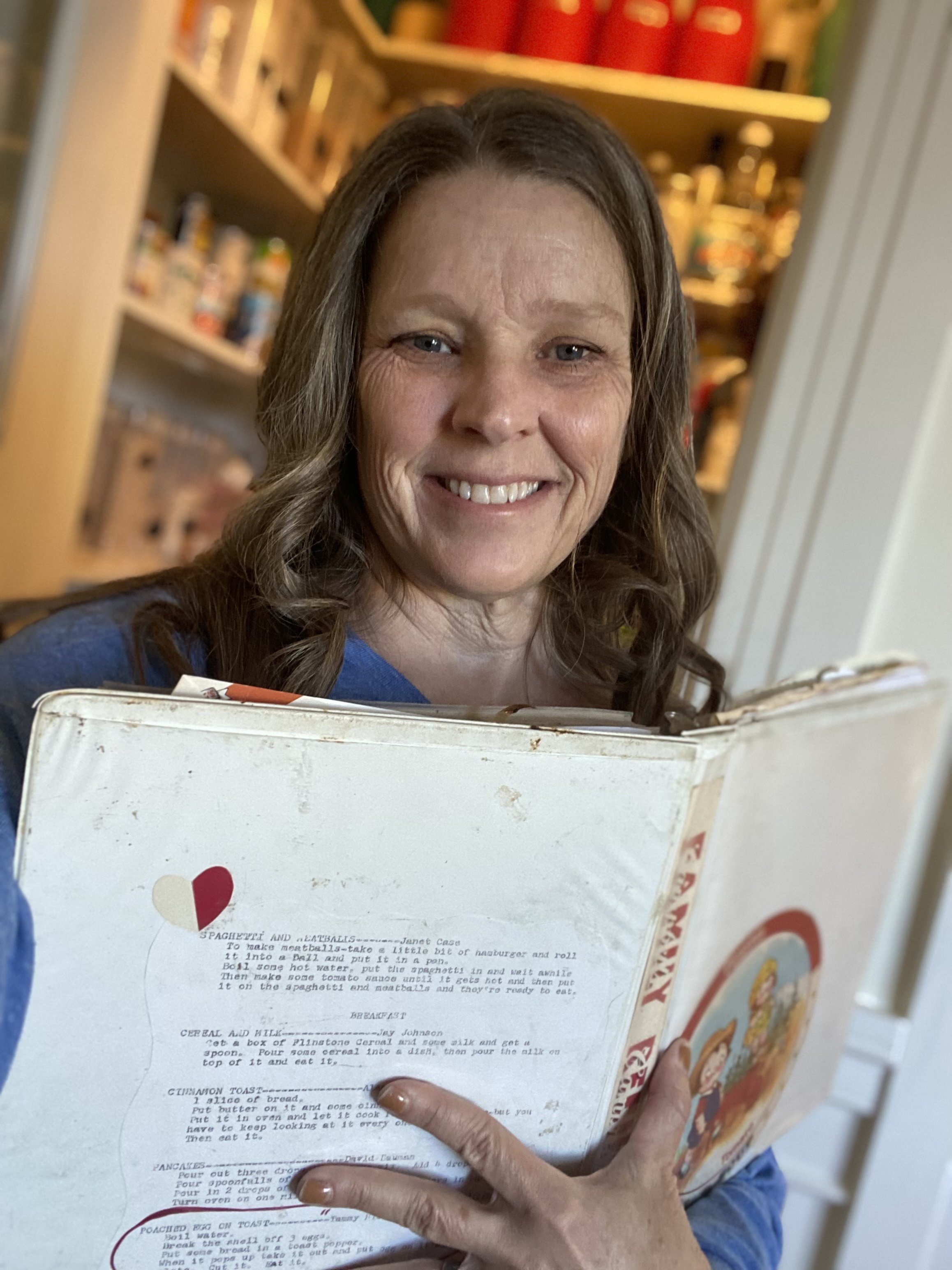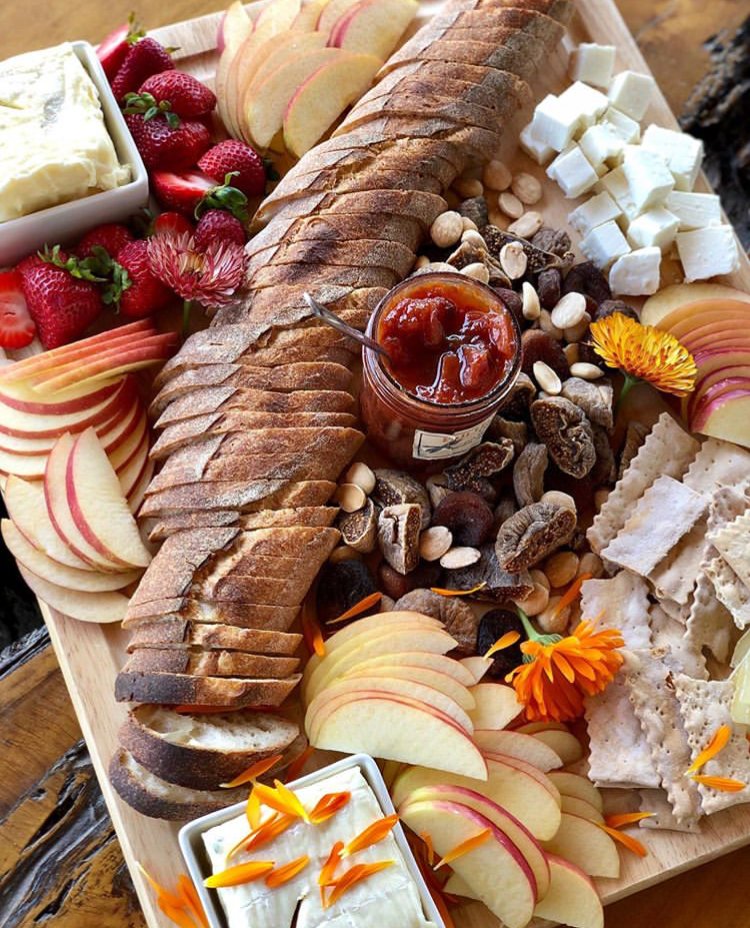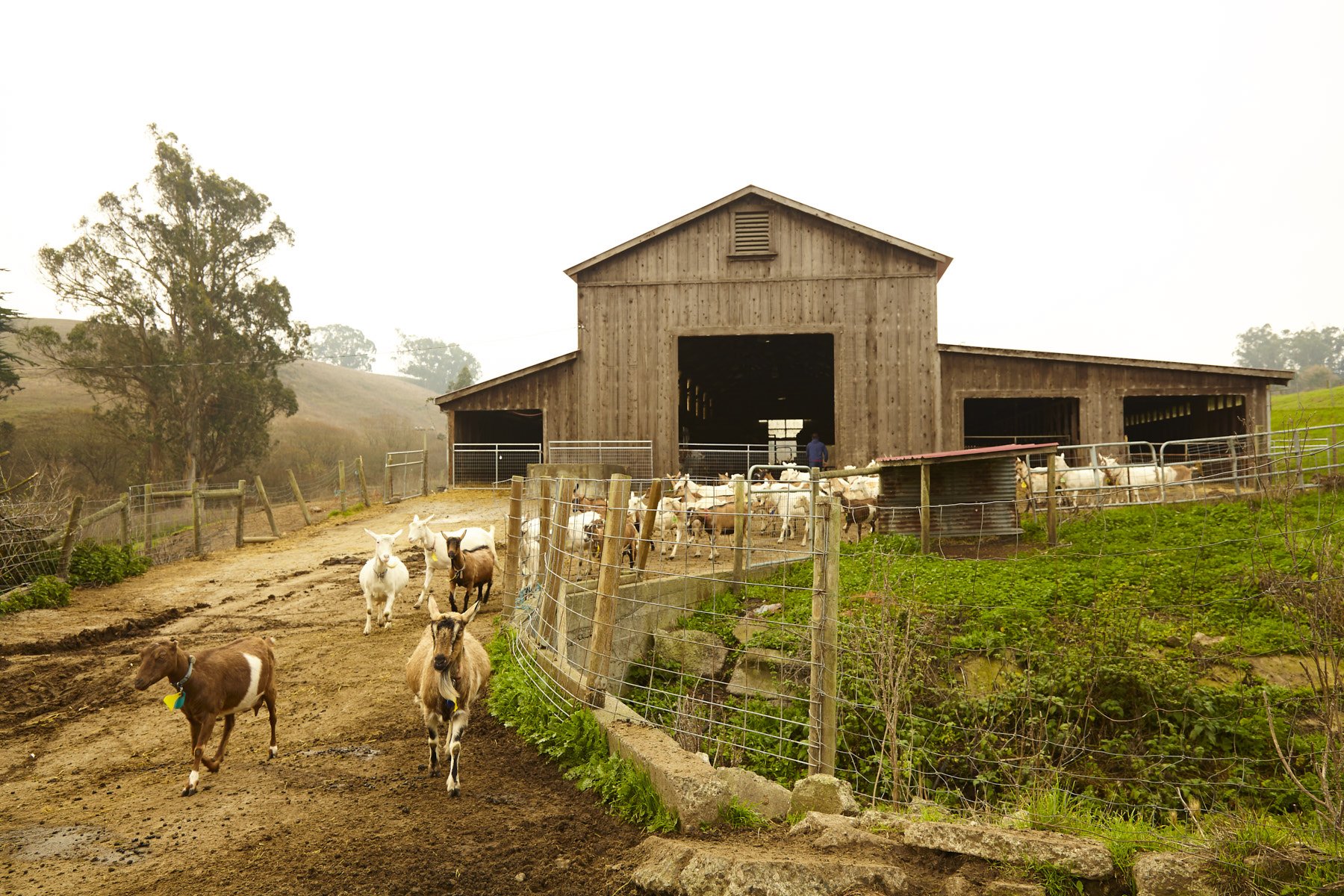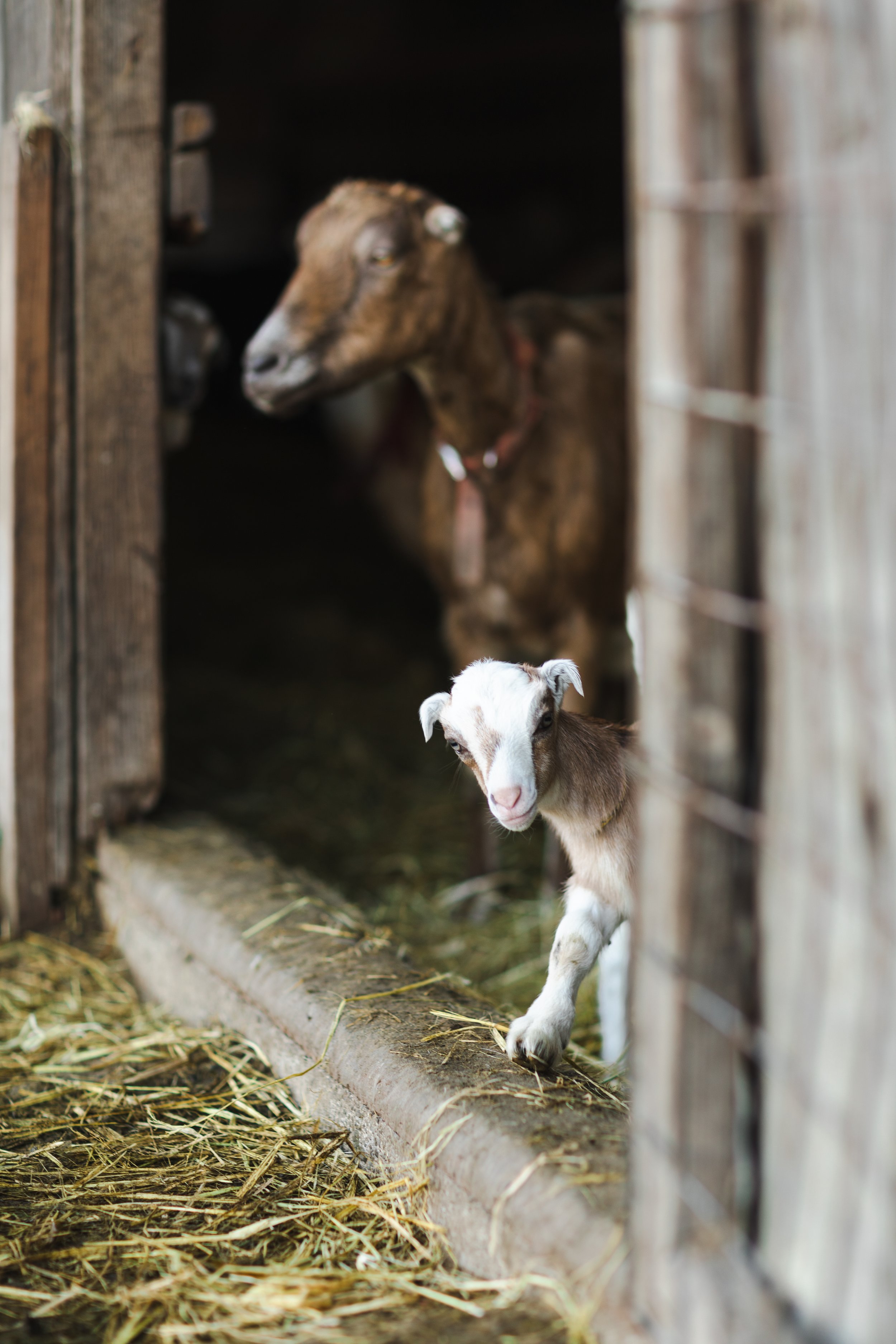Reality Bites is a feature series focused on the relationships people have with food, what kinds of cooking they’re inspired and sustained by, and the ingredients and tools that help them along the way.
Cheesemaker, farmer, and clinical psychologist Tamara Hicks is likely to be spotted in the small town of Tomales in West Marin, 60 miles north of San Fransisco’s Bay Bridge. She and her husband restored and now run the beautiful 160-acre Toluma Farms & Tomales Farmstead Creamery, where they raise the sheep and goats that produce their delicious cheese. Across the Bay, they run Daily Driver, a beloved local bagel business with an on-site creamery. When she’s not selling cheese at a local farmer’s market, she might be at one of her favorite local restaurants, or spending time on the East Coast in Brooklyn or in Hudson, NY. We talked to Tamara about growing up in Oklahoma, her great-grandmother’s chocolate cake, and the fine art of making cheeseboards.
What is your morning routine like?
One of my new favorite phrases is “hurkle-durkle,” which is a Scottish phrase to describe lounging around in bed long after you should get up. I am a bit spoiled in that David, my husband of 30 years, brings me my cappuccino every morning. This allows me to spend the first hour of the day in bed, catching up on emails and writing down the things I would like to accomplish during the day in my notebook. I am a big fan of putting things on paper — I still use a paper planner and notebook.
Once out of bed, I spend the morning at our organic, wood-fired bagel business and San Francisco’s only cheese-making facility, Daily Driver. After three to four hours connecting with our managers and working on HR, finances, and community programming, I head to our farm, Toluma Farms, and spend the afternoon with my hands in soil, hanging out with our goats, sheep, chickens, and our talented and committed team. I am incredibly fortunate to be able to split my time between a dynamic urban setting and a rural, slow-paced setting.
how did you go from a career as a psychologist to starting Toluma Farms & Tomales Farmstead Creamery, and then Daily Driver?
The multiple businesses sound a bit crazy, but in my mind, they all intersect very nicely. Since I spend most of my time these days on our farm or at Daily Driver, I only get to see about 6 clients a week in my practice as a psychologist. I deeply loved my career as a psychologist and feel fortunate that it is a career that carries over to all of the other endeavors I am involved in.
In the mid-nineties, when my kids were young, I started paying attention to what I was feeding them. This was also around the time that the Slow Food Movement from Italy was making its way to San Francisco and Climate Change talks were happening. In my own private practice, my colleagues and I were seeing a big increase in people suffering from depression and anxiety. It was evident to me that our entire health ecosystem was broken. People were not in nature as much as they used to be, they weren’t moving their bodies as much as they used to due to increased screen time, and they had lost connection with other people and animals. Buying a farm that was no longer in the local food shed, restoring it, and opening it up to the public has given me a concrete and hopefully lasting way to make a positive difference in the lives of others. Since not everyone in San Francisco can make it to the farm, we opened Daily Driver to bring the farm experience to urban eaters.
what drew you to cheesemaking?
The 160-acre farm we purchased, which sits on unceded Coast Miwok land, was a cow dairy for about 70 years until it shut down. My husband and I had restored vintage cars and houses, so we believed we could restore the farm to what was. Cows sort of freaked us out — or more the size of their manure freaked us out. We wanted animals that were lighter on the land and we loved goat and sheep cheeses, so that is what we went with. I took a couple of courses in cheesemaking, locally in Marin and in Vermont, and learned how to make wonderful quark, chevre, kefir, and ricotta, but these courses weren’t enough to make great, complicated cheeses so we have hired a cheesemaker to help us make our award-winning cheeses. I focus on the soil health which affects the water and grasses that the animals consume. I believe that if the animals are on healthy soil, then they will be healthy, and in turn provide us with the best milk possible, thus making extraordinary cheese!
I believe one of my strengths — and it comes from my career as a psychologist — is putting together and nurturing exceptional teams of people. Once you have put together an exceptional team, magic happens and absolutely anything can be accomplished.
What is your earliest food memory?
My earliest food memories are with my great-grandmother Opal, in Oklahoma. Although I was born in rural San Diego, I was raised in Oklahoma from the time I was a week old until 3rd grade. Opal and my grandpa Joe were tenant farmers and also had a magical homestead of their own. I remember sitting on the back porch with her and shelling beans from the garden, and I remember collecting eggs from the chickens and her showing me how to make deviled eggs. Mine were a mess. I was too afraid to cut through the yolk, so I cut around it, making my edges really crazy. One of my earliest memories of kindness and support was her looking at that mess and saying they were the most beautiful deviled eggs she’d ever seen. Maybe I was destined to have a farm to rekindle these experiences of connection and love through food.
What did you eat growing up, and how did it influence your taste?
My parents were teen parents who dropped out of high school to have my brother, and then I followed a year later. In the early days living in Oklahoma, we didn’t have much money, so my mother had a garden in order to grow and can her own food. We didn’t go out to eat much or have fast food — it was more cost-effective to eat at home. It is something I think of often when I hear criticism that farmers’ markets or organic food is only for the wealthy. My relationship with gardens and growing your own food was quite the opposite and I do believe that growing your own food and cooking with it is by far more economical than any other way of sourcing food.
In my teen years, we lived in rural San Diego and were doing better economically and the food we consumed included much more industrial, fast food, and was not diversified ethnically. There were no farmers’ markets and the big box grocery stores did not have local, organic products. My mom grew avocados and she had fruit trees such as pomegranates and pears, so I still had a small connection to local, delicious food. When I moved to San Francisco after college I vowed to eat differently. Being in the Bay Area made that very easy. I started going to Ferry Building Farmers' Market and shopping at a worker-owned co-op, Rainbow Grocery. I have never looked back. I am very mindful of what it is like to live in a food desert. People often eat poorly not out of choice but out of a lack of access to better choices available to them.
what does a typical day at the farm look like?
There is no typical day at the farm — that is one of the things I love about farming!! In the morning I ask myself what the three things that will break today will be, so when they do break I am not as frustrated (this was good advice from a local rancher). Even though we are in California, our farm is very seasonal. The goats and sheep breed in the fall and kid and lamb in the spring, so during the spring at the farm, it is all things baby animals. This is when our tours, farm stays, and cheese tastings are at their peak. In the late fall, after breeding, and throughout the winter, we are focusing on land management and repairs of fencing and equipment. For instance, yesterday my day was spent seeding pastures before one of the last rains comes in later this week. I planted herbs and edible flowers that we use for our cheese boards and provide for our farm stay guests to enjoy. We also replaced an old fence and gave a tour to high school students, and I met with our apprentice who is training our new livestock guardian dog, a Great Pyrenees puppy.
Do you have any cheeseboard-making tips? How do you like to present food to guests?
I love making cheeseboards — I make a couple a week for our farm tours. Just like the days at the farm, no two cheese boards are the same. I encourage people to be adventurous and look at what they have in their pantry, fridge, yard, or neighborhood. I only buy what is in season, so my cheese boards are like a love letter to the current season!! I first put the cheeses on the board — I like to have a combo of a fresh cheese, a soft-ripened cheese, or something that is aged for a month or two, and an aged cheese. I like the variety of textures and tastes that the various ages offer. I also like mixing up animals, so I will often have a goat, sheep, and cow, or a mixed milk cheese. Then I add in some sweet and savory items around the cheese. For summer that can be strawberries, blackberries, peaches, blueberries, and edible flowers. For fall it is often apples from the farm, figs, and persimmons. For winter I add in rosemary and fennel that is grown on the farm, mandarins, pears, pomegranates, local olives, and dark chocolate, and often a jam made from fruits that we had during the summer. For spring, honey is always welcome, as well as things like fava bean leaves. For all the boards I then add some nuts for a crunchy texture, and bread or crackers. Most importantly, have fun with it, and remember there are no rules. It is an opportunity to add a little creativity to your day by making something beautiful!
what does a typical day of eating look like for you?
I have never been hungry in the morning and have had people telling me for most of my life that breakfast is the most important meal of the day and that I wasn’t healthy for skipping it. In the last couple of years, I have been okay with not eating breakfast — I’m humored, in fact, by the intermittent eating trend — and I no longer feel bad about it. I listen to my body and eat when I am hungry and that might look different than someone else.
I start out with a cappuccino from my husband and a glass of water. For lunch, I have a meal salad — a salad with lots of things from the market in it that changes daily. Between lunch and dinner (since we eat late), I often have our cheese. I literally make myself a cute cheese board for one (I think presentation in food is important as it deserves to look nice) of one of our cheeses, a jam, nuts, and olives. It feels very indulgent. If I am eating our fresh chevre, then I often put it on an apple or fig. If I am eating one of our soft-ripened cheeses I will add honey or an apricot jam. As a woman, I feel that the calcium and protein in cheese is actually what my body wants for a snack. My body also often wants a perfect, warm chocolate chip cookie. I have a few go-to places that make them, but I will also whip up a batch in the afternoon just to eat a few by myself — self-care at its finest. For dinner, my husband and I cook together or we go out to one of our favorite restaurants, often where we know the owners or chefs and many of the customers. Local restaurants and farmers’ markets are a bit like our church, it is where we connect with the bigger community.
One of the very best things about making cheese is selling it at farmers’ markets and thus trading or buying from the farmers’ market each week. I’ve come to know almost the day when blueberries will appear, or when pears will show up. When you shop at the farmers’ market you can’t get strawberries or asparagus or anything all year round, as everything has a peak local season. The beauty of this is that, while you are sad to say goodbye to a favorite fruit or veggie, you are oh so happy to taste something that you haven’t had for 8 months. We are lucky to have our fridge and pantry full of local farmers' bounty.
what are your essential cookbooks?
I am fortunate to know Alice Waters from Chez Panisse. She is a heroine of mine. My admiration is not only for the groundbreaking restaurant she opened in the 70s and her commitment to local, slow food and never wavering but also for the way she builds community and mentors others. I know many chefs that have worked at Chez and she motivated them to start their own businesses. She is never threatened by competition; she only wants more good food out in the world. Her cookbooks, especially The Art of Simple Food, are my cooking bibles! Another is Judy Rodgers’ cookbook from Zuni Cafe — an iconic restaurant that is one of my favorites. I am also a huge fan of the work of La Cocina, which is a kitchen and business incubator. Their cookbook We Are La Cocina is amazing, it has everything from Nepalese dumplings to Mexican tamales. I have a bit of an obsession with cookbooks and could list so many favorites. For those that live in or visit the Bay Area, one of my go-to stores is Omnivore Books, which carries new and vintage cookbooks.
What are your go-to recipes?
I am partial to my great-grandmother Opal’s chocolate sheet cake. It reminds me of her, is easy to make and it is the cake all of my family wants for their birthdays. My mother would make it for my birthday. It’s also meant for communal eating. My great-grandmother would bring it to church camp in Oklahoma. When I got married my mother typed up all the recipes from my grandparents and great-grandparents and put them in a three-ring binder. If our house caught on fire it is one of the first things I would grab and save.
what’s your essential cookware?
Sharp knives (we are lucky to live close to Bernal Cutlery, which is a gem of a knife shop). My husband can’t live without his cast iron pans and I love our vintage Le Creuset Dutch ovens, which were gifts from my mother-in-law. We get a lot of use out of our Tramontina 10-inch fry pan and our All-Clad stainless steel straight-sided sauté pan and stock pot.
favorite servingware?
Heath. Edith Heath began making ceramics in San Francisco in 1948, a time when not many women were making ceramics for retail. She continued this business in Marin County until the early 2000s when she sold the business. I love her story and love the simple yet beautiful and functional design.
Can you tell us a little bit about an especially memorable meal you’ve had?
Our kids (Josy, Emmy, and Megan) are now grown and recently when we were all together over Thanksgiving break in Hudson, NY, our kids, their partners, and their partners’ siblings made all the food (led by our future son-in-law, Nico) — not only for Thanksgiving but for four straight days. I loved focusing on setting a beautiful table and letting the surprise of the meal unfold. It is a joy to see them buy food from their favorite purveyors, take risks in cooking something they read or heard about, and freely cook a variety of different ethnic foods which hasn’t been the norm in our family. We are fortunate to have kids who revel in good food, whether it is the simple pleasure of a fresh tomato or a more complicated Korean dish they made. I know this is something they will carry on throughout their lives and that is incredible.
What are your favorite cafes, restaurants, bakeries, and local food makers? Where do you get take-out (if you do)?
It’s a long list!! We spend most of our time in four places — San Francisco, West Marin, Brooklyn, and Hudson, NY — and I have my favorites in each of these locations. Each of these places value direct purchases from farmers and do not cut corners.
In West Marin, our favs are The Marshall Store, Tony’s, De Havilland, and Route One Bakery & Kitchen. Route One has the best chocolate chip cookies, which is the food I would most likely choose if I had only one food item to take on a desert island — but they have to be damn good and these are. There is no indoor seating so everyone hangs outside at the bar-height seating. Going there is an opportunity to see all of the neighbors — mostly ranchers, farmers, and artists. I believe bakeries are often the soul of a town and that is true for this bakery and our small little town.
In San Francisco and the Bay Area, our favs are Piccino, Zuni, Che Fico, Dumpling Time, Farmhouse Thai, Chez Panisse, Besharam, and (of course!) Daily Driver.
In Hudson, NY, it is insane how many good restaurants, cafes, bakeries, and food makers there are. Some favorites are Casa Susanna, Lil Deb's Oasis, Cafe Mutton, Feast and Floret, and Stissing House. In Hudson, we buy most of our food at the Morningstar Farm store and all of our dairy (including raw milk) at Churchtown Dairy.
In New York City, are favs are King, Roberto’s, Misi, Lula Mae, Place des Fêtes, Roman’s, Miss Ada, and Dept of Culture.
all images provided by tamara jo hicks, edited by meghan racklin

